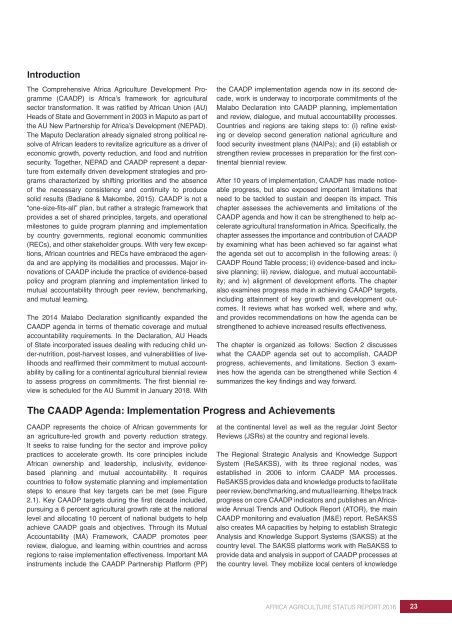AFRICA AGRICULTURE STATUS REPORT 2016
AASR-report_2016-1
AASR-report_2016-1
Create successful ePaper yourself
Turn your PDF publications into a flip-book with our unique Google optimized e-Paper software.
Introduction<br />
The Comprehensive Africa Agriculture Development Programme<br />
(CAADP) is Africa’s framework for agricultural<br />
sector transformation. It was ratified by African Union (AU)<br />
Heads of State and Government in 2003 in Maputo as part of<br />
the AU New Partnership for Africa’s Development (NEPAD).<br />
The Maputo Declaration already signaled strong political resolve<br />
of African leaders to revitalize agriculture as a driver of<br />
economic growth, poverty reduction, and food and nutrition<br />
security. Together, NEPAD and CAADP represent a departure<br />
from externally driven development strategies and programs<br />
characterized by shifting priorities and the absence<br />
of the necessary consistency and continuity to produce<br />
solid results (Badiane & Makombe, 2015). CAADP is not a<br />
“one-size-fits-all” plan, but rather a strategic framework that<br />
provides a set of shared principles, targets, and operational<br />
milestones to guide program planning and implementation<br />
by country governments, regional economic communities<br />
(RECs), and other stakeholder groups. With very few exceptions,<br />
African countries and RECs have embraced the agenda<br />
and are applying its modalities and processes. Major innovations<br />
of CAADP include the practice of evidence-based<br />
policy and program planning and implementation linked to<br />
mutual accountability through peer review, benchmarking,<br />
and mutual learning.<br />
The 2014 Malabo Declaration significantly expanded the<br />
CAADP agenda in terms of thematic coverage and mutual<br />
accountability requirements. In the Declaration, AU Heads<br />
of State incorporated issues dealing with reducing child under-nutrition,<br />
post-harvest losses, and vulnerabilities of livelihoods<br />
and reaffirmed their commitment to mutual accountability<br />
by calling for a continental agricultural biennial review<br />
to assess progress on commitments. The first biennial review<br />
is scheduled for the AU Summit in January 2018. With<br />
the CAADP implementation agenda now in its second decade,<br />
work is underway to incorporate commitments of the<br />
Malabo Declaration into CAADP planning, implementation<br />
and review, dialogue, and mutual accountability processes.<br />
Countries and regions are taking steps to: (i) refine existing<br />
or develop second generation national agriculture and<br />
food security investment plans (NAIPs); and (ii) establish or<br />
strengthen review processes in preparation for the first continental<br />
biennial review.<br />
After 10 years of implementation, CAADP has made noticeable<br />
progress, but also exposed important limitations that<br />
need to be tackled to sustain and deepen its impact. This<br />
chapter assesses the achievements and limitations of the<br />
CAADP agenda and how it can be strengthened to help accelerate<br />
agricultural transformation in Africa. Specifically, the<br />
chapter assesses the importance and contribution of CAADP<br />
by examining what has been achieved so far against what<br />
the agenda set out to accomplish in the following areas: i)<br />
CAADP Round Table process; ii) evidence-based and inclusive<br />
planning; iii) review, dialogue, and mutual accountability;<br />
and iv) alignment of development efforts. The chapter<br />
also examines progress made in achieving CAADP targets,<br />
including attainment of key growth and development outcomes.<br />
It reviews what has worked well, where and why,<br />
and provides recommendations on how the agenda can be<br />
strengthened to achieve increased results effectiveness.<br />
The chapter is organized as follows: Section 2 discusses<br />
what the CAADP agenda set out to accomplish, CAADP<br />
progress, achievements, and limitations. Section 3 examines<br />
how the agenda can be strengthened while Section 4<br />
summarizes the key findings and way forward.<br />
The CAADP Agenda: Implementation Progress and Achievements<br />
CAADP represents the choice of African governments for<br />
an agriculture-led growth and poverty reduction strategy.<br />
It seeks to raise funding for the sector and improve policy<br />
practices to accelerate growth. Its core principles include<br />
African ownership and leadership, inclusivity, evidencebased<br />
planning and mutual accountability. It requires<br />
countries to follow systematic planning and implementation<br />
steps to ensure that key targets can be met (see Figure<br />
2.1). Key CAADP targets during the first decade included,<br />
pursuing a 6 percent agricultural growth rate at the national<br />
level and allocating 10 percent of national budgets to help<br />
achieve CAADP goals and objectives. Through its Mutual<br />
Accountability (MA) Framework, CAADP promotes peer<br />
review, dialogue, and learning within countries and across<br />
regions to raise implementation effectiveness. Important MA<br />
instruments include the CAADP Partnership Platform (PP)<br />
at the continental level as well as the regular Joint Sector<br />
Reviews (JSRs) at the country and regional levels.<br />
The Regional Strategic Analysis and Knowledge Support<br />
System (ReSAKSS), with its three regional nodes, was<br />
established in 2006 to inform CAADP MA processes.<br />
ReSAKSS provides data and knowledge products to facilitate<br />
peer review, benchmarking, and mutual learning. It helps track<br />
progress on core CAADP indicators and publishes an Africawide<br />
Annual Trends and Outlook Report (ATOR), the main<br />
CAADP monitoring and evaluation (M&E) report. ReSAKSS<br />
also creates MA capacities by helping to establish Strategic<br />
Analysis and Knowledge Support Systems (SAKSS) at the<br />
country level. The SAKSS platforms work with ReSAKSS to<br />
provide data and analysis in support of CAADP processes at<br />
the country level. They mobilize local centers of knowledge<br />
<strong>AFRICA</strong> <strong>AGRICULTURE</strong> <strong>STATUS</strong> <strong>REPORT</strong> <strong>2016</strong><br />
23


